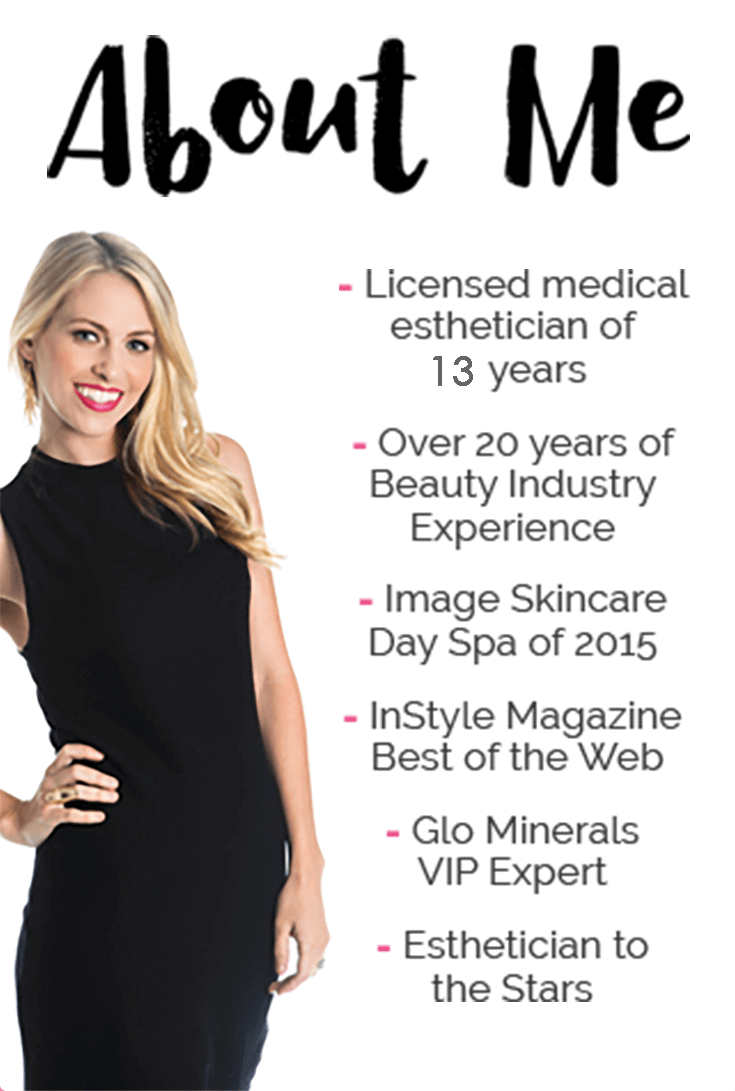What Should You Be Using In Your Skin Care Routine?
Take my quiz and get personalized recommendations from a
licensed esthetician!
Product Spotlight: Rhonda Allison's Pumpkin Cleanser
Today I want to spotlight one of my absolute favorite products: Rhonda Allison's Pumpkin Cleanser. With a wonderfully appealing scent, the Pumpkin Cleanser is a daily "treatment" cleanser that leaves skin squeaky clean using the benefits of L-lactic acid for exfoliation and hydration, while pumpkin extracts provide digestion and antioxidant support for healthier, more glowing skin. Pumpkin, often referred to as "nature's natural collagen", contains the highest content of naturally occurring Vitamin A and beta carotene of any other fruit
 Focus Ingredients - Cucurbita Pepo
Focus Ingredients - Cucurbita Pepo
In addition, pumpkin, one of the largest natural providers of the most concentrated sources of zinc, is also naturally high in beta carotene, vitamin C, and vitamin A. Zinc, an essential bio-element and vital component of many enzyme reactions, is present in every part of the body and has a wide range of functions. Naturally used by the body as the basis for L-superoxide dismutase and enzymes responsible for the production of DNA and RNA, Zinc also boosts the immune system at the cellular level, increases T-cells, is antibacterial, accelerates the healing of wounds, and is essential for cell growth, healthy skin, and a healthy immune system resistance to infection.
Beta carotene, another component found in pumpkin, is a compound shown in some research to reduce the risk of cancer, acting as a potent antioxidant to inhibit free radical damage and the formation of UV radiation induced tumors. As a natural substance that prevents call damage from excess oxygen, it also neutralizes singlet oxygen to fight further damage to the skin from outside elements.
Vitamins A & C, also found in pumpkin, are another source of naturally occurring, free radical-fighting antioxidants. These highly touted vitamins are believed to help fend off diseases such as cancer and heart disease. While vitamin C can keep the skin's elastic fibers, or collagen, from breaking down, vitamin A targets receptors responsible for activating cell turnover.
 L-Lactic Acid (10%) - Softens protein, hydrating and encourages exfoliation - Lactic acid, an alpha hydroxyl acid, or AHA, helps to increase desquamation and evenly thin the stratum corneum. This process is especially helpful for aging skin because exfoliation slows down with age. AHAs in general are weak organic acids, with a terminal corboxyl (acid) group and hydroxyl (OH) on the carbon atom that follows (the alpha carbon). The carbon chain varies in length, and is only two carbons in the case of glycolic acid. AHAs are a family of fruit acids which include Glycolic (from sugar cane), Malic (from apples), Tartaric (from grapes), Mandelic (from bitter almonds), Citric (from citrus friets), Phytic (from rice) and Lactic (from sour milk).
L-Lactic Acid (10%) - Softens protein, hydrating and encourages exfoliation - Lactic acid, an alpha hydroxyl acid, or AHA, helps to increase desquamation and evenly thin the stratum corneum. This process is especially helpful for aging skin because exfoliation slows down with age. AHAs in general are weak organic acids, with a terminal corboxyl (acid) group and hydroxyl (OH) on the carbon atom that follows (the alpha carbon). The carbon chain varies in length, and is only two carbons in the case of glycolic acid. AHAs are a family of fruit acids which include Glycolic (from sugar cane), Malic (from apples), Tartaric (from grapes), Mandelic (from bitter almonds), Citric (from citrus friets), Phytic (from rice) and Lactic (from sour milk).
AHAs affect the epidermis, causing cells to shed more quickly and certain skin layers to thicken. AHAs work in two basic ways: First, they loosen or dissolve (depending upon the strength) the glue-like substances that hold the outer layer of cells together and to the underlying epidermis. With this loosening effect, the dull, dry stratum corneum is sloughed off, therby allowing a more smooth texture, refined appearance of pores, the diminished appearance of fine lines and better utilization of skin care products or medications. (Imagine your skin layers as a brick wall, the AHAs work on the "mortar" between the "bricks" of dead cells.) Second, they are known to affect deeper levels of the skin by regenerating collagen and elastin. AHAs in general are used to treat photoaging because they improve uneven pigmentation, smooth out fine lines, improve skin texture, and increase skin flexibility when the synthesis of glycosaminoglycans (GAGs) and collagen increases. A note of caution, AHAs may increase photosensitivity and irritate sensitive skin and that of rosacea patients.
D-Beta Carotene - Antioxidant, increases cell turnover, and protects skin from photo damage -  Found in many vegetables and fruits, D-beta carotene is a precursor of vitamin A. Responsible for pigmentation qualities, such as the orange color of carrots, D-beta carotene is considered an antioxidant which increases resistance to various environmental stresses. Often termed "proVitamin A", D-beta carotene is widely used in cosmetics as a tinting agent in makeup products and sunless tanning lotions, cleansers, moisturizers, aftershave lotions, and facial skin care products.
Found in many vegetables and fruits, D-beta carotene is a precursor of vitamin A. Responsible for pigmentation qualities, such as the orange color of carrots, D-beta carotene is considered an antioxidant which increases resistance to various environmental stresses. Often termed "proVitamin A", D-beta carotene is widely used in cosmetics as a tinting agent in makeup products and sunless tanning lotions, cleansers, moisturizers, aftershave lotions, and facial skin care products.
D-beta carotene is often used for its antioxidant properties and photoprotective abilities, helping to even the skin tone; thus giving it the name "anti-aging" ingredient where its attributes are used to prevent the signs of aging in the skin and its tinting abilities are used to promote a continuous suntant while protecting the skin from sun damage. (Although, it should be noted that D-beta carotene should never be used as a sunscreen.)
In addition, skin care professionals often use D-beta carotene for its ability to increase cell turnover and regeneration in the outer layers of the skin as an effective treatment against diseases and skin conditions related to epithelium damage here topical application can enhance the appearance of the skin by restoring suppleness and evening out skin tone. D-beta carotene's corrective properties may also be used in skin creams to help heal scratches, prevent scarring, and reduce skin irritation and itchiness.
 Zingiber Officinale (Ginger) Root Oil - Contains many antioxidants and is commonly used to treat inflammation - Although called a root, ginger root is actually the rhizome of the monocotyledonous perennial plant Zingiber officinale. The main constituents are sesquiterpenoids with zingiberene as the main component. Lesser amounts of other sesquinterpenoids (sesuiphellandrene, disabolene and farnesene) and a small monterpenoid fraction (phelladrene, cineol, and citral) have also been identified.
Zingiber Officinale (Ginger) Root Oil - Contains many antioxidants and is commonly used to treat inflammation - Although called a root, ginger root is actually the rhizome of the monocotyledonous perennial plant Zingiber officinale. The main constituents are sesquiterpenoids with zingiberene as the main component. Lesser amounts of other sesquinterpenoids (sesuiphellandrene, disabolene and farnesene) and a small monterpenoid fraction (phelladrene, cineol, and citral) have also been identified.
The characteristic odor and flavor of ginger root is caused by a mixture of zingerone, shoagoles and gingerols, volatile oils that compose about 1%-3% by weight of fresh ginger. The gingerols have analgesic, sedative and antibacterial motility effects.
 Eugenia Cryophyllus (Clove) Leaf Oil - Fragrance ingredient which contains antioxidant activity and used primarily as a natural anesthetic and antiseptic stimulant - Clove has been cultivated the world over for more than 2,000 years. The oil has long been used in Chinese medicine for detoxification and to stimulate the circulatory system. Its aroma also helps to stimulate the mind.
Eugenia Cryophyllus (Clove) Leaf Oil - Fragrance ingredient which contains antioxidant activity and used primarily as a natural anesthetic and antiseptic stimulant - Clove has been cultivated the world over for more than 2,000 years. The oil has long been used in Chinese medicine for detoxification and to stimulate the circulatory system. Its aroma also helps to stimulate the mind.
This volatile essential oil comprises in total 23 indentified constituents, among them eugenol, which funcations as a fragrance ingredient and denaturant (76.8%), followed by caryophyllen (17.4%), humulene (2.1%), and eugenyl acetate (1.2%) as the main components. In a clinical study, this essential oil demonstrated scavenging activity and a significant inhibitory effect against hydroxyl radicals as well as acting as an iron chelator. With respect to the lipid peroxidation, the inhibitory activity of clove oil, using a linoleic acid emulsion system, indicated a higher antioxidant activity than the standard BHT.
Clove oil is also used as an carminative and insecticide in addition to being used for its therapeutic benefits on ailments such as gout, measles, tuberculosis, colds and flu, scabies, ulcers, and wounds. In addition, clove is often applied to the skin as a counter-irritant for pain and for mouth and throat inflammation. When applied directly to the gums, clove oil is also used for toothaches, for pain control during dental work, and for a complication of tooth extraction called "dry socket".
 Cinnamomum Cassia (Cinnamon) Leaf Oil - Primarily used for its potent antibacterial and antifungal properties, as well as its stimulation effects - It is the terpenoids found in the oil believed to promote a glowing, healthy complexion. It also contains phenolic compounds, flavonoid derivatives, and its antimicrobial and antioxidant properties work to tighten and lift the skin. In medicine it acts like other volatile oils and once had a reputation as a cure for colds. It has also been used to treat diarrhea and other problems of the digestive system.
Cinnamomum Cassia (Cinnamon) Leaf Oil - Primarily used for its potent antibacterial and antifungal properties, as well as its stimulation effects - It is the terpenoids found in the oil believed to promote a glowing, healthy complexion. It also contains phenolic compounds, flavonoid derivatives, and its antimicrobial and antioxidant properties work to tighten and lift the skin. In medicine it acts like other volatile oils and once had a reputation as a cure for colds. It has also been used to treat diarrhea and other problems of the digestive system.
According to resent studies from Cabello CM, Bair WB, Lamore SD, Ley S, Bause AS, Azimian S, Wondrak GT (January 2009), research has documented anti-melanoma activity of cinnamic aldehyde observed in cell culture and a mouse model of human melanoma. The therapeutic properties of cinnamon oil are analgesic, antiseptic, antibiotic, antispasmodic, aphrodesiac, astringent, cardiac, carminative, emmenagogue, insecticide, stimulant, stomachic, tonic, and vermifuge. Cinnamon oil can also be used for infection of the respiratory tract, rheumatism, arthritis, and general pains. It calms an exhausted feeling of depression, tones the whole body, and stimulates the glandular system, thus easing period pains.
Cinnamon is being used all over the world for treating a variety of health disorders including respiratory problems, skin infections, blood impurity, and heart disorders where its most widely used part is its bark. Cinnamon is also rich in essential minerals such as manganese, iron, and calcium and is rich in fibuer. Cinnamon leaf oil, with its warm, spicy, musky smell, and the oil's color varies from yellow for the leaf oil and red-brown for the bark oil, which is not usually used in aromatherapy. Cinnamon oil extracted from the leaf is considered non-toxic; however, due to the emenagogue action of the oil, it should be avoided in pregnancy.
Composition - Aqua (Water), Hecyl Glucoside, Sodium Lauroyl Lactylate, Butyrospermum Parkii (Shea Butter), Comcamidopropyl Hydroxysultaine, Glycol Distearate, Limnanthes Alba (Meadowfoam) Seed Oil, Cocamindopropyl Bataine, Cucurbita Pepo (Pumpkin) Seed Oil, L-Lactic Acid, Benzyl Alcohol. D-Beta-Carotene, Sodium Chloride, Zingiber Officinale (Ginger) Root Oil, Eugenia Coryophyllus (Clove) Leaf Oil, Cinnamomum Cassia (Cinnamon) Leaf Oil.
Top Brands
New Brands

Recent Posts

Are You Taking the Right Steps to Care for Your Skin?
Take the Quiz
Skincare Secrets!
10-step guide for healthy, beautiful skin after kids.
100% privacy. I will never spam you!













